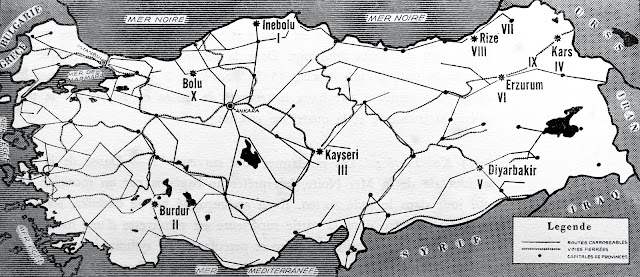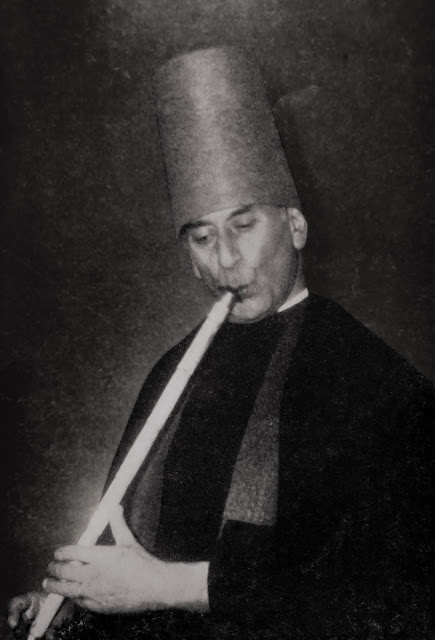Rythmes et Mélodies de Turquie – Le Club Français du Disque 92, recorded by Blaise Calame, 1957 (10 in, 33 RPM)
"In Turkey, popular music has long been
overlooked and neglected compared with art music. It is actually one of the
most interesting aspects of Turkish cultural life, now found solely in the countryside
and remote mountainous regions. It is in these least accessible regions that
one finds the most authentic examples of a musical art which occupies a special
place in Middle-Eastern music," wrote violin player Blaise Calame in the 1957
French liner notes.
« Pendant longtemps la musique populaire a été sous-estimée en
Turquie et négligée au profit de la musique savante. Elle représente pourtant
un des aspects les plus intéressants de la vie culturelle, développée dans les
campagnes et les nombreuses contrées montagneuses et retirées de la Turquie.
C'est même dans les régions les moins accessibles que l'on trouve les spécimens
les plus authentiques d'un art musical qui occupe une place à part dans la
musique du Proche-Orient, » affirme le violoniste Blaise Calame dans le
livret accompagnant ce disque écrit en 1957.
A1 – Horon.
An intense fast-paced Black Sea fishermen’s dance performed on a three-stringed
kemençe violin near Rize, in the
Eastern Black Sea region.
A2 – Dag
Havasi / Mountain Air. A funeral oration from the mountainous region of
Kars, in Eastern Anatolia, performed on the ancient double-reed mey, which, at the time, was still being
played in certain mountainous areas.
A3 – Süpürgesi Yoncadan. Dance from the Bolu region, in Central Anatolia;
the saz player sings a love song
entitled The Clover Broom.
A4 – Avsar Beyleri / The Lords of the Avsar (name of a people from
ancient Turkey). Dance from the Burdur region, in southern Anatolia, performed
on the saz.
A5 – Köçeri.
Dance from Erzurum, in Eastern Anatolia, played on the quircky oboe-like zurna.
B1 – Sinsin.
Dance around a fire from Kayseri, Central Anatolia. The orchestra composed
includes two saz, a cura saz, a meydan sazi, and the darbuka drum.
B2 – Koroglu.
Epic folk song from the region of Kars and Erzurum. An asik (wandering minstrel) plays the meydan saz and sings about the
bravery of Koroglu, a legendary 16th-century hero and bard.
B3 – Hemsin
Horonu. Three dances from the mountainous region south of Rize, in the
Eastern Black Sea region, performed around a tulum bagpipe player.
B4 – Kol
Basti / The Police Have Come. A dance from the western coast of the Black
Sea, performed on the saz lute and darbuka drum. The song refers to a former
regime which banned popular entertainment. As the police approach, the music is
subdued until they leave.
B5 – Halay.
A dance from Diyar Bakir, "the land of copper," in Eastern Anatolia,
played on the double-reed mey and darbuka drum.
Our other Turkish music posts:
Photographs below are from The Illustrated Guide to Islam: History, Philosophy, Traditions, Teachings, Art and Architecture by Raana Bokhari, Lorenz Books, 2012, and Musique de Turquie - Les Traditions Musicales by Ursula Reinhard, Buchet-Chastel, 1997:
Miniature Ottoman astrological zodiac chart, which illustrates mankind's divine predestination, 1583:
Epic-story singer Kir Ismail, aka Ismail the Grey, playing the cura saz,
Haruniye, Adana Province:
Haruniye, Adana Province:
Halil Can (1905-1973) playing the ney flute:
Davul drum player:
Please help me purchase important traditional records to pursue my global curation project and share the best finds with you on this blog:









Love the website but the links are not working anymore :(
ReplyDeleteUnfortunately I'm getting Dropbox 404 error on different machines and browsers :(
Deletehttps://www.dropboxforum.com/t5/Files-folders/Error-404-We-can-t-find-the-page-you-re-looking-for/m-p/306517
Fantastic music, the liner notes are an interesting read. And the extra images are great.
ReplyDeleteTHANK YOU!
Teşekkürler...
ReplyDelete